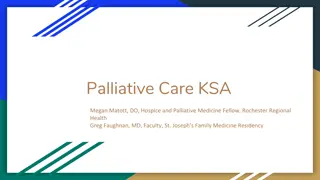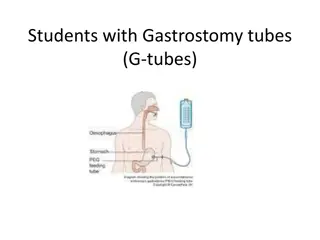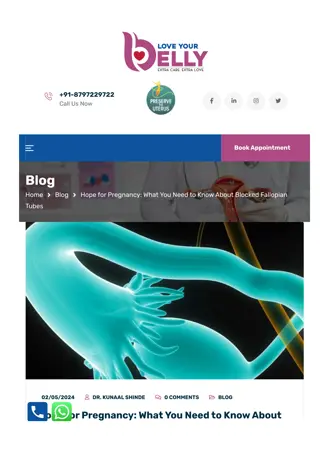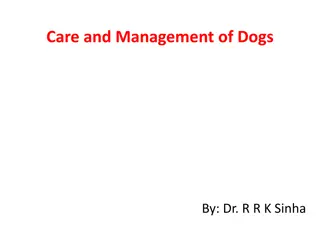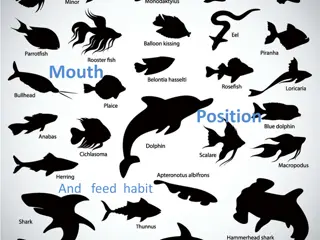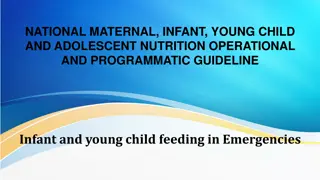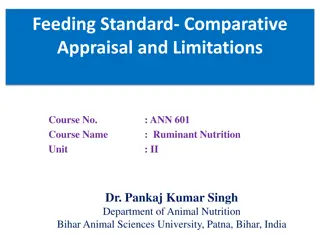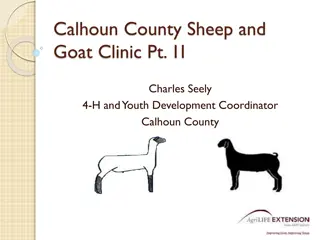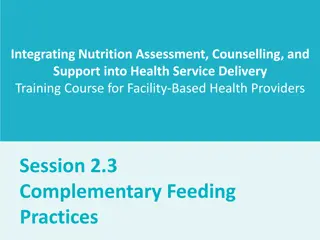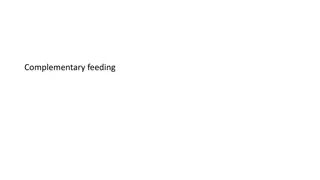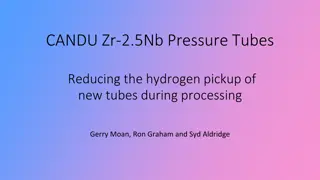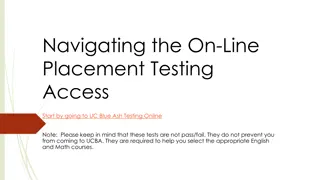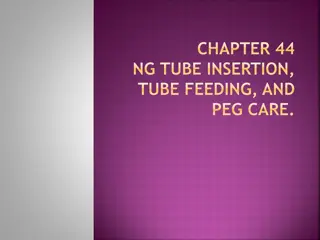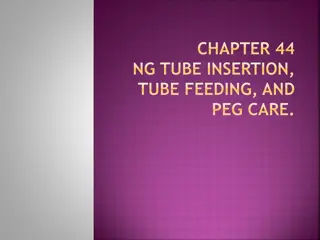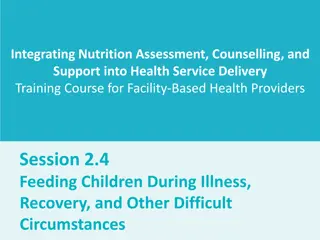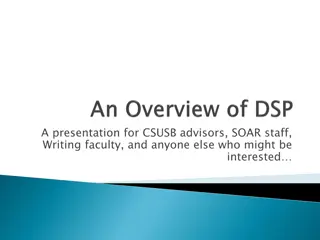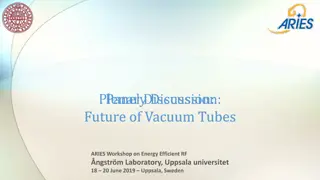Understanding Feeding Tubes: Types, Placement, and Care
Feeding tubes, such as gastrostomy and jejunostomy tubes, are used to provide nutrients when a patient is unable to eat normally. They come in various types and are placed through surgical or endoscopic procedures. Proper care, including site management, formula orders, and emergency protocols, is crucial for the patient's well-being. Family education is also essential.
Download Presentation

Please find below an Image/Link to download the presentation.
The content on the website is provided AS IS for your information and personal use only. It may not be sold, licensed, or shared on other websites without obtaining consent from the author. Download presentation by click this link. If you encounter any issues during the download, it is possible that the publisher has removed the file from their server.
E N D
Presentation Transcript
My patient has a feeding tube What does that mean? Martha Kliebenstein, MSN, RN Clinical Educator
Types of tubes Gastrostomy (G-tube) Gastrostomy jejunostomy (G-J tube) Naso gastric (NG tube) Naso jejunal (NJ tube) Jejunostomy (J tube)
Naso gastric tube NG placement Initial insertion pH test X-ray verification measurement Confirmed placement Measurement Q shift Prior to feeds/meds
How are they placed? Gastrostomy tube: Surgical gastrostomy tube placement Open incision laparotomy Percutaneous Endoscopic Gastrostomy Tube placement (PEG) Done via endoscopy First tube change typically in 3 months
How are they placed? Gastrojejunal Placed through the catheter of the gastrostomy tube Image result for gj tube
How are they placed? Gastro-Jejunostomy tube Used when gastric feeds not tolerated Placed in interventional radiology (after initial tube is placed) Often placed through gastrostomy tube Two options Gastric outlet vented, clamped, some meds Jejunal outlet feeds, meds Clogs very easily Flush, flush, flush
How are they placed? Jejunostomy tube Placed directly into the jejunum Surgical procedure Placed when a child s probability of tolerating gastrostomy feeds is unlikely Image result for jejunostomy tube
Nursing cares to think about with all tubes Policy and Procedures Site care management Enteral formula orders Emergency management for dislodgement Management for blocked/clogged tube Management of complex site care Family teaching needs
Nursing cares to think about with all tubes What type of tube Type of skin care Bolster dressing or split gauze Any creams being applied Time frame for feeds
Nursing cares to think about with all tubes Flushing use bottled water; seltzer water if sluggish What volume do you flush with? 2 -3 ml for gtube after meds/feeds 5 ml Q 4 hours j-port of g-j tube even if feeding is infusing Do you flush before and/or after meds; between each med? Use 5 ml syringe or greater when flushing less negative pressure on tube
open to air OR split gauze? Image result for split 2x2 under g tube
Giving meds though a enteral tube Meds via Gtube or J tube Meds in liquid form preferably Capsules/pills must be crushed well FLUSHING before and after meds are given
Gastrojejunostomy OR Jejunostomy tube Many children will have BOTH gastrostomy tube for venting and some meds AND jejunostomy tube for feeds and some meds ORDERS TO CLARIFY Which port is for meds? For feeds? Is the g-tube clamped or to gravity? Do we replace GTube output? Make sure MD order is correct with route may need to call MD to reflect accurate route Jejunostomy tube feeds must be given as a continuous infusion NOT bolus feed
Giving meds though a enteral tube Meds via Gtube or J tube Meds in liquid form preferably Capsules/pills must be crushed well FLUSHING before and after meds are given
How to care for the site Clean with soap and water Daily and prn Assess site for redness, drainage, bleeding, granulation tissue Diaper creams can be used; If fungal > Nystatin cream -- Need MD orders Stomahesive powder can be sprinkled at site May use ProNet to secure tube
Stabilization of the tube Holds the balloon/mushroom against the stomach wall Prevent stomach contents from leaking Prevent tube from sliding to far into the stomach or into small intestine Prevent skin erosion around insertion site Remove extension set from button tube
Feeding techniques Bolus Specific amount over shorter time period Usually 20-60 minutes Can give via gravity (syringe or feeding bag) or enteral feeding pump If given too fast can cause stomach discomfort Bolus feeds NEVER given into jejunostomy tube
Feeding techniques Drip/continuous feeds At a continuous rate over a period of time Do not need to be given over 24 hours usually over 18 24 hours Necessary when patient has jejunal feeds Must flush Q 4 hours and when feeds disconnected as well as before/after medications Breast milk/specially prepared formula can hang no greater than 4 hours Commercial formula can hang no greater than 8 hours
Venting? Gravity? Venting: Allows stomach to be vented or burped Can be done before, during or after feeds If stomach contents come up, typically allow contents to return into stomach Gravity: Allow stomach to drain Similar to decompression of stomach May require fluid replacement of contents that are secreted
Residual? Routinely not done Done only in specified situations Need MD order Often done if abdominal distention, feeding intolerance Must make clinical assessment
Cecostomy tube CHRONIC CONSTIPATION Antegrade VERSUS Retrograde Less invasive Independent management easier for children
Where should they be? Gastrostomy tube? Image result for childs abdomen Gastrojejunal tube? Jejunostomy tube? Cecostomy tube? Always verify placement with family and check the LDA
Trouble shooting Granulation tissue Pink, moist tissue May have yellow, green and bloody drainage Keep site clean and dry Triamcinolone 0.5% or silver nitrate treatment Leaking at site Gently pull back on tube to ensure snug against stomach wall May need to change button if size incorrect May need stabilization tube Check balloon for appropriate water volume Remember: primary tube issues must contact GT RN or MD
Trouble shooting Yeast Tiny, red bumps Tends to look moist May use nystatin cream or powder (MD order) Site red, irritated Dampness, gastric leakage Dry dressing when moist need to keep site dry Barrier shield wipes may be used Stomahesive powder Kaltostat Moisture barriers (desitin, triple paste, etc)
Trouble shooting Tube clogged Refer to P&P key points are: Check for kinks; Flush with water, may need carbonated water IF GJ tube need to go to IR for re-insertion Tube out Not an emergency Place gauze over site and contact MD/GT nurse on call Have about 1 hour before stoma will start to close If primary tube do not replace; notify surgery If established tract trained RN or GT nurse on call can replace
Whats the problem? Whats your nursing intervention? Tube flange laying along skin causing irritation Small granuloma at top of site; scar tissue on side Tube is to short causing tube imbedding into skin needs to be re-measured May need ointment following new tube
Whats the problem? Whats your nursing intervention? Fungal infection, need for nystatin cream and/or powder; clean with warm soap and water, 2x2 gauze Tube opening enlarged, possibly due to tube movement; need to stabilize and use kaltostat cream to allow closure hopefully
Whats the problem? Whats your nursing intervention? Tissue prolapse possibly often bleeds easily; keep clean and use barrier cream (A&D, desitin) Tube has not been rotated sufficiently or tube to short causing skin breakdown and also small blister; consider mepilex dressing
Whats the problem? Whats your nursing intervention? Tube is to long can cause leaking and/or skin issues; tube needs to be re-measured; check water balloon -
Where do I find info? Policy and Procedures Enteral Feeding G/J tube site care and maintenance Patient and Family Education: Caring for a child with a g-tube On line Resource Gtube resource page on Children s Connect www.chw.org/gtube (videos and content)


